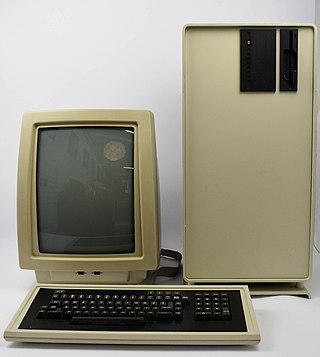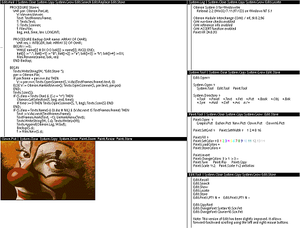The Modula programming language is a descendant of the Pascal language. It was developed in Switzerland, at ETH Zurich, in the mid-1970s by Niklaus Wirth, the same person who designed Pascal. The main innovation of Modula over Pascal is a module system, used for grouping sets of related declarations into program units; hence the name Modula. The language is defined in a report by Wirth called Modula. A language for modular multiprogramming published 1976.

Niklaus Emil Wirth was a Swiss computer scientist. He designed several programming languages, including Pascal, and pioneered several classic topics in software engineering. In 1984, he won the Turing Award, generally recognized as the highest distinction in computer science, "for developing a sequence of innovative computer languages".

Oberon is a general-purpose programming language first published in 1987 by Niklaus Wirth and the latest member of the Wirthian family of ALGOL-like languages. Oberon was the result of a concentrated effort to increase the power of Modula-2, the direct successor of Pascal, and simultaneously to reduce its complexity. Its principal new feature is the concept of type extension of record types. It permits constructing new data types on the basis of existing ones and to relate them, deviating from the dogma of strictly static typing of data. Type extension is Wirth's way of inheritance reflecting the viewpoint of the parent site. Oberon was developed as part of the implementation of an operating system, also named Oberon at ETH Zurich in Switzerland. The name was inspired both by the Voyager space probe's pictures of the moon of the planet Uranus, named Oberon, and because Oberon is famous as the king of the elfs.
An object-oriented operating system is an operating system that is designed, structured, and operated using object-oriented programming principles.
Component Pascal is a programming language in the tradition of Niklaus Wirth's Pascal, Modula-2, Oberon and Oberon-2. It bears the name of the language Pascal and preserves its heritage, but is incompatible with Pascal. Instead, it is a minor variant and refinement of Oberon-2 with a more expressive type system and built-in string support. Component Pascal was originally named Oberon/L, and was designed and supported by a small ETH Zürich spin-off company named Oberon microsystems. They developed an integrated development environment (IDE) named BlackBox Component Builder. Since 2014, development and support has been taken over by a small group of volunteers. The first version of the IDE was released in 1994, as Oberon/F. At the time, it presented a novel approach to graphical user interface (GUI) construction based on editable forms, where fields and command buttons are linked to exported variables and executable procedures. This approach bears some similarity to the code-behind way used in Microsoft's .NET 3.0 to access code in Extensible Application Markup Language (XAML), which was released in 2008.

The DISER Lilith is a custom built workstation computer based on the Advanced Micro Devices (AMD) 2901 bit slicing processor, created by a group led by Niklaus Wirth at ETH Zurich. The project began in 1977, and by 1984 several hundred workstations were in use. It has a high resolution full page portrait oriented cathode ray tube display, a mouse, a laser printer interface, and a computer networking interface. Its software is written fully in Modula-2 and includes a relational database program named Lidas.

Oberon-2 is an extension of the original Oberon programming language that adds limited reflection and object-oriented programming facilities, open arrays as pointer base types, read-only field export, and reintroduces the FOR loop from Modula-2.

In computing, text-based user interfaces (TUI), is a retronym describing a type of user interface (UI) common as an early form of human–computer interaction, before the advent of bitmapped displays and modern conventional graphical user interfaces (GUIs). Like modern GUIs, they can use the entire screen area and may accept mouse and other inputs. They may also use color and often structure the display using box-drawing characters such as ┌ and ╣. The modern context of use is usually a terminal emulator.
Kronos is a series of 32-bit processor equipped printed circuit board systems, and the workstations based thereon, of a proprietary hardware architecture developed in the mid-1980s in Akademgorodok, a research city in Siberia, by the Academy of Sciences of the Soviet Union, Siberian branch, Novosibirsk Computing Center, Modular Asynchronous Developable Systems (MARS) project, Kronos Research Group (KRG).

QEMU is a free and open-source emulator. It emulates a computer's processor through dynamic binary translation and provides a set of different hardware and device models for the machine, enabling it to run a variety of guest operating systems. It can interoperate with Kernel-based Virtual Machine (KVM) to run virtual machines at near-native speed. QEMU can also do emulation for user-level processes, allowing applications compiled for one architecture to run on another.
A2 is a modular, object-oriented operating system with unconventional features including automatic garbage-collected memory management, and a zooming user interface. It was developed originally at ETH Zurich in 2002. It is free and open-source software under a BSD-like license.
The MicroBlaze is a soft microprocessor core designed for Xilinx field-programmable gate arrays (FPGA). As a soft-core processor, MicroBlaze is implemented entirely in the general-purpose memory and logic fabric of Xilinx FPGAs.
Wirth's law is an adage on computer performance which states that software is getting slower more rapidly than hardware is becoming faster.
Lola is designed to be a simple hardware description language for describing synchronous, digital circuits. Niklaus Wirth developed the language to teach digital design on field-programmable gate arrays (FPGAs) to computer science students while a professor at ETH Zurich.
LatticeMico32 is a 32-bit microprocessor reduced instruction set computer (RISC) soft core from Lattice Semiconductor optimized for field-programmable gate arrays (FPGAs). It uses a Harvard architecture, which means the instruction and data buses are separate. Bus arbitration logic can be used to combine the two buses, if desired.

Algorithms + Data Structures = Programs is a 1976 book written by Niklaus Wirth covering some of the fundamental topics of system engineering, computer programming, particularly that algorithms and data structures are inherently related. For example, if one has a sorted list one will use a search algorithm optimal for sorted lists.

Active Oberon is a general purpose programming language developed during 1996-1998 by the group around Niklaus Wirth and Jürg Gutknecht at the Swiss Federal Institute of Technology in Zürich. It is an extension of the programming language Oberon. The extensions aim at implementing active objects as expressions for parallelism. Compared to its predecessors, Oberon and Oberon-2, Active Oberon adds objects, system-guarded assertions, preemptive priority scheduling and a changed syntax for methods. Objects may be active, which means that they may be threads or processes. As it is tradition in the Oberon world, the Active Oberon language compiler is implemented in Active Oberon. The operating system named Active Object System (AOS) in 2002, then due to trademark issues, renamed Bluebottle in 2005, and then renamed A2 in 2008, especially the kernel, synchronizes and coordinates different active objects.
The Ceres Workstation was a workstation computer built by Niklaus Wirth's group at ETH Zurich in 1987. The central processing unit (CPU) is a National Semiconductor NS32000, and the operating system, named Oberon System is written fully in the object-oriented programming language Oberon. It is an early example of an operating system using basic object-oriented principles and garbage collection on the system level and a document centered approach for the user interface (UI), as envisaged later with OpenDoc. Ceres was a follow-up project to the Lilith workstation, based on AMD bit slicing technology and the programming language Modula-2.
Modula-2 is a structured, procedural programming language developed between 1977 and 1985/8 by Niklaus Wirth at ETH Zurich. It was created as the language for the operating system and application software of the Lilith personal workstation. It was later used for programming outside the context of the Lilith.
Jürg Gutknecht is a Swiss computer scientist. He developed, with Niklaus Wirth, the programming language Oberon and the corresponding operating system Oberon.










